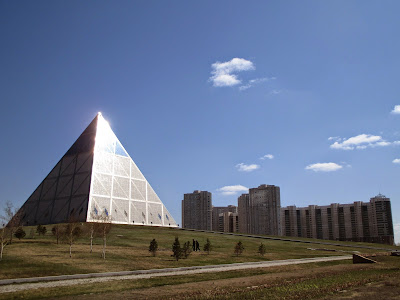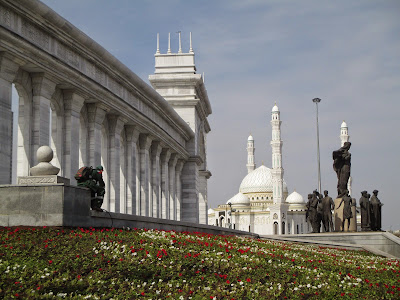Astana. After Bishkek stucked in its
soviet past, Almaty desespertly normal and rooted in the present, we
are in the future now. The new capital of Kazakhstan is a futuristic
city that appeared out of the desert about 15 years ago. Nursultan
Nazarbaev, first (and still current) president of Kazakhstan, decided
soon after the independance of the country to rise a new capital for
21st century's Kazakhstan, as well as for his own ego. The
skyline of the new city is impressive, and so unsual that many
conspiracy theories see in Astana either an evidence of Illuminati's
hand holding the world, either a capital for the New World Order. I
must admit, without giving credits to any of this, the city is
strange and a walk in its center surprising.
Let's start the visit with the most
curious monument of the city. The pyramid is conceived to be the
geographical and symbolic center of the city when Astana will have
reach its planned extents. The place is named Palace of Peace and
Accord. It was built to host regulary the Congress of World and
Traditionnal Religions. In the underground is an opera theater.
Climbing up in a diagonal elevator, you pass by several floors
dedicated to administrative offices, meeting halls and exhibition
galleries before to reach the upper part of the pyramid. The last
thing to cross before to arrive at the top is a ridiculous winter
garden of fake plastic flowers. The upper part is a conference hall
called the Cradle hall, with windows decorated by stained-glass
doves. A special elevator, reserved for the president Nazarbaev,
brings him directly to this hall. ''Jesus
Christ!'' says Tince with astonishment, but if Jesus would come here,
he would have to take the stairs. It's weird to imagine the
religious leaders and representants of the world gathering around
Nazarbaev, in this place full of symetry and symbolism. Outside and
nearby the pyramid, you can see a recent but beautiful mosque.
Although this is the largest mosque in Central Asia, the building is
still smaller than the pyramid, as the cult of the president has more
importance here than Islam.
Crossing the
river, you can find the residence of the president, Ak Orda. The
parliament, the senate, the tribunal can all be find at a
near-distance and all the powers of the country are gathered around
the same square. Two shiny golden-glassed towers keep the entrance to
the place. On top of the residence itself you can see a sun, carried
by a flying eagle, same as on the Kazakh flag. This solar symbol
makes me think about Ancient Egypt, at a time when new pharaos
regulary moved their capital to a new built city with temples
dedicated to their own cult and where the previous pharaos could be
forgotten.
In the city center rises another
strange monument : Bayterek. A tower crowned by a glass golden
ball. Bayterek is supposed to represent the Tree of Life, and to
remind a Kazakh legend where a mythical bird lays a golden egg
containing the secrets of Human desires and happiness in the top of
that tree. The place is a strange mix of modern architecture, Kazakh
mythology and cult of personnality. In the golden orb, one can enjoy
a great overview on the city and place his hand in a print of
Nazarbaev's hand, in a golden triangle at the center of it.
The center of Astana is built on an
east-west axis, with a large esplanade linking all those places. In
the morning, the sun rises behind the glass pyramid, at noon it
passes over Bayterek, and sets in the evening behind a large
transluscent tent : Khan Shatyr. The material used for the tent
is so that the temperature inside remains the same all year long.
Inside the yurt is a big shopping mall. When visiting the place, I
think about the symbolism of this. In Kazakh nomadic culture, the
yurt is the center of the family life and traditions. Isn't it
representative of modern lifestyle to bring this temple of
consumption in the very core of family life ?
The architecture of this city is indeed
impressive, and gives the city of being in a megalopolis. However this
feeling is still somewhat artificial and misleading. Sometimes if one
turns into the wrong street behind this or this tower, one can arrive
out of the city, facing the desert. The city is unfinished and in many
parts cranes are just part of its skyline. In the Palace of
Independance, it is possible to see the city plan and have an outlook
on how the city should look like in 2050. For instance, behind Khan
Shatyr will be built an inside city, a complex of building with the
capacity of 1 million of people who will be able to enjoy a life
inside with constant 27°C of temperature, and
also parks and river. People living here have very different opinion
about this city, some liking it and some don't. I don't know about
living here but it's definitly worth a visit! After almost two weeks
here, there's only one place left to see : the airport, which will
take us home tomorrow!


















This comment has been removed by a blog administrator.
ReplyDelete